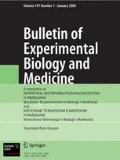Abstract
The ability of the antitumor analogs of luliberin (LH-RH), a hypothalamic peptide hormone, to stimulate the immune function of T cells is examined in experiments with the gene coding for interleukin-2 (IL-2). Recombinant MIL2C or 4×Pu DNA containing the marker gene of chloramphenicol acetyltransferase (CAT) under the control of a 2.2 kb promoter of murine IL-2 gene or four copies of purine-rich element (from −292 to −246 base pairs), respectively, is injected inXenopus laevis oocytes. The promoter activity is blocked by inoculation of the protein fraction of nuclear extracts from resting mouse splenic T cells. The IL-2 gene promoter is dereppressed after injection of the short LH-RH analog L1 (7 amino acid residues) into the oocyte nucleus or cytoplasm. The addition of L1 or L2 (an LH-RH analog consisting of 10 amino acid residues) to the incubation medium activates mouse splenic T cells and stimulates the synthesis of IL-2 mRNA 2- to 3-fold more intensely than ConA+rIL-2, judging from dot-blot andin situ hybridization data. Cytological analysis of cell culture shows that the presence of L1 and L2 peptides in the culture medium promotes differentiation of T cells. It is hypothesized that the antitumor activity of these peptides is associated with the stimulation of IL-2 synthesis.
Similar content being viewed by others
References
T. B. Kazakova, O. I. Golovko, T. V. Grishina,et al., Byull. Eksp. Biol. Med.,117, No. 5, 523–527 (1994).
T. Kazakova, A. Myul'berg, S. Burov,et al.,, 112, No. 7, 89–92 (1991).
N. Azad, C. Agrawal, M. Emmanueleet al., Am. J. Reprod. Immunol.,26, No. 2, 160–172 (1991).
G. Chipens, E. Korneva S. Skljarova,et al., in:Interactions of Immune and Central Nervous Systems: Search of the Afferent Signals, Riga (1987), pp. 1–54.
P. Chomczynski and N. Sacchi,Anal. Biochem.,162, No. 1, 56–159 (1987).
C. Gorman, L. Moffat, and B. Howard,Mol. Cell. Biol.,2, No. 4, 1044–1051 (1982).
T. B. Kazakova, O. I. Golovko, G. V. Gushchin,et al., Biotechnol. Ther.,4, No. 1-2, 63–76 (1993).
A. Mouzaki, R. Weil, L. Muster, and D. Rungger,EMBO J.,10, No. 4, 1399–1406 (1991).
F. Rasmussen,Horm. Res.,32, No. 1, 47–49 (1989).
Author information
Authors and Affiliations
Additional information
Translated fromByulleten' Eksperimental'noi Biologii i Meditsiny, Vol. 122, No. 9, pp. 334–337, September, 1996
Rights and permissions
About this article
Cite this article
Kazakova, T.B., Burov, S.V., Golovko, O.I. et al. Biological activity of analogs of the peptide hormone luliberin in the regulation of the immune response of T cells. Bull Exp Biol Med 122, 943–946 (1996). https://doi.org/10.1007/BF02446589
Received:
Issue Date:
DOI: https://doi.org/10.1007/BF02446589


